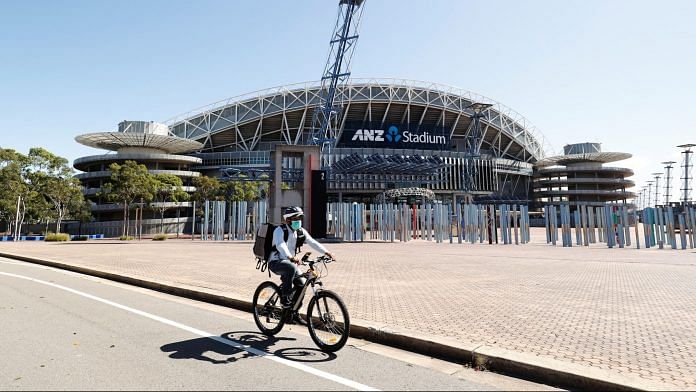Sydney/Canberra/Melbourne: Australia’s second lockdown in the city of Melbourne seems to be failing to slow the coronavirus’ spread, a sign that governments are running out of options to contain the pathogen as it reemerges across the globe.
Three weeks after the population of 5 million was put under lockdown again in response to a fierce flareup, the infection curve in Victoria state, which Melbourne is the capital of, hasn’t flattened. Instead, cases have surged, with a record 723 new infections on Thursday and a further 627 on Friday, raising fears the virus will spread nationwide.
A shopping cart is left abandoned on a deserted street in the Docklands area of Melbourne, on July 9.
The lockdown’s lack of results is confirming suspicions that strict social distancing measures — which helped contain first waves across Asia and Europe earlier this year — are becoming increasingly ineffective as the pandemic heads into its eighth month and populations become weary of the disruption.
With those unable to work from home desperate not to sacrifice wages, and young people especially losing patience with physical isolation, many no longer seem willing to fully follow the rules as the economic and social costs mount.
Also read: J&J’s experimental vaccine protects monkeys from Covid with single shot, reveals study
“Unless everyone plays their part this lockdown will not end anytime soon,” Victorian Premier Daniel Andrews said Thursday. “There are still some people who, for whatever reason, whether it be frustration, fatigue, whether it be some of those economic hardship issues, are making the wrong choice.”
Public health officials will analyze the data to determine what’s going wrong, Andrews said Friday, and warned the restrictions may need to be tightened further.
The lockdown fatigue could leave little in the arsenal for governments as they battle flareups from Hong Kong to Spain, Vietnam to Belgium. If mandated social distancing fails, the global outbreak could accelerate before an effective vaccine is developed and distributed, unless new strategies of surveillance and containment are found.
Australia’s first lockdown that lasted roughly from March to May was one of the most successful in the world, bringing down cases to just a handful a day nationwide. But security failures at quarantine hotels for returning travelers and poor communication of critical information to migrant communities allowed the virus to roar back in Victoria, its second-most-populous state.
With some 10,000 cases now after the addition of hundreds of new infections daily for nearly a month, Victoria accounts for more than 60% of Australia’s total since the pandemic began. Worryingly, deaths are also growing as the outbreak has spread to aged-care homes.
Also read: Virus surge as summer wanes in Australia indicates what US, Europe can expect this winter
Facing the new lockdown, many Australians are weighing up the social and financial cost of retreating once more, particularly when it’s not clear when restrictions will end, said Emma McBryde, a professor of infectious disease and epidemiology at James Cook University in Australia’s Queensland state.
An advertisement thanking medical workers is displayed in Sydney, on May 18.
“We’re not going to eliminate Covid-19 so we’re going to have to work out how to manage it in ways that aren’t extremely damaging,” McBryde said. Simple practices, widely applied — like frequent hand-washing, mask wearing and social distancing — may be more digestible than lockdowns, she said.
Some economists argue that the second lockdown’s porousness shows Australia isn’t looking after its poorest citizens properly, since many have proved unable to heed orders to self-isolate when infected. Authorities have pleaded in vain for workers to stay at home when unwell, even paying them to isolate while waiting for the results of a test.
This resurgence has notably hit poorer migrant communities in Melbourne, a group that the government has been accused of neglecting in testing and outreach prior to the infection spike.
“For some people, taking a week or two off work is the difference between having a roof over your head or being in poverty,” said Callam Pickering, Asia-Pacific economist at recruitment portal Indeed.com in Melbourne. “They don’t have the finances to take that time off.”
People wait in line outside a Centrelink office in the Bondi Junction suburb of Sydney, on March 24, 2020.
Australia’s not alone in struggling to balance strict measures and the harm they do to the most disadvantaged. Hong Kong, which is also facing an aggressive virus resurgence, abruptly reversed a ban on dining-in for breakfast and lunch one day after it was enacted, as pictures of senior citizens and blue collar workers eating on pavements and in parks went viral.
To be sure, while new infections haven’t dropped, Melbourne’s outbreak hasn’t seen cases explode exponentially either — which could have happened had the lockdown not been implemented.
Members of the Australian Defence Force (ADF) assist people at a drive-in Covid-19 testing site in Melbourne, on Jun 30.
But before a vaccine is developed and widely distributed, Australia’s limbo is likely to be replicated elsewhere.
“People know what is coming and how tedious lockdown and social distancing policies can be,” Nicholas Thomas, associate professor in public health at the City University of Hong Kong, said by email. “Governments and their populations have to decide what they want — the pandemic to end or to try to go back to normal economic life knowing that it will be disrupted.”
-Bloomberg
Also read: US drug authority could allow emergency use of plasma therapy for Covid-19, reveals report






